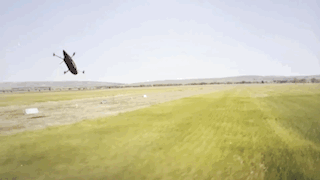Introducing the Airspeeder MK4!
If this vehicle looks like a big, flying car, it is precisely what the manufacturer was looking to achieve. The Alauda eVTOL (electric vertical and take-off & Landing vehicle) takes to the open sky and the endless amount of racetrack it can supply.
What is Airspeeder? Matt Pearson founded Airspeeder, which is:
a flying car racing series developed in 2016 with the vision of accelerating the next-generation mobility revolution through healthy competition.
Pearson is also the founder of Alauda Aeronautics, and according to Forbes, Alauda is providing the technology to underpin the Airspeeder. The business model operates very similarly to Formula E racing. (Formula E is an electric car, one-seater racing on the ground): Alauda will then provide the hardware to multiple teams to manufacture and develop their airspeeders and train their pilots.
Here is the earliest, smaller scale, flying racing car as developed by Alauda with the designation of MK1.
They have come a long way since the MK1, with the introduction of the MK3, a remotely piloted aircraft.
MK3 Testing (media by JC)
This is the dawn of personal air mobility — the age of human-crewed electric flying cars has arrived. Alauda Aeronautics builds electric Vertical Take Off and Landing (eVTOL) aircraft that can be owned and flown by anyone.

For the moment, Alauda’s primary focus is supplying eVTOLs to the Airspeeder racing series with the introduction of the MK4. What is the MK4? It is the world’s first human-crewed flying electric racing car with some pretty impressive specifications, starting with an air speed of 160km/hr (99mph) and a 0 to 60mph time of 2.3 seconds. This vehicle was made to be the formula 1 of the skies. All this speed and agility comes from a motorized device weighing a hefty 400kg (881 lbs). You can expect an average racing height of around 196 feet above the ground.
The MK4 operates at 6000rpm with eight motors and eight propellers. Expect 5 to 20 minutes per battery for flight time. This will continue to become a moving target as battery technology improves.
Also of importance is the amount of safety baked into these racing vehicles. Equipped with Lidar, Radar, and many sensors and cameras, the MK4 will maintain stability and a safe distance should a rotor fail, or the aircraft get too close to the competition.
The pilot will access augmented reality (AR) visors, providing sophisticated digital governed track guidance throughout the course. HUD (Heads Up Display) ensures the pilot has all pertinent data without looking down. This includes speed, altitude, horizon, battery strength, and overall performance.

As we have learned in the past with vehicles in general. Sports like racing have brought several innovations to the aircraft, boats, and cars used in everyday life. I expect we will reap the rewards of what is learned while racing these eVTOLs. In any case, it is a stepping stone to finally realizing the “Flying Car” dream.



